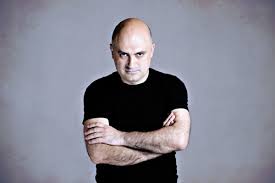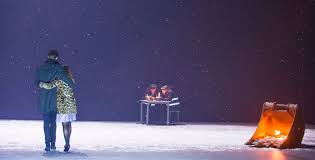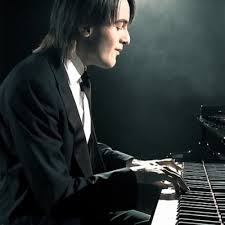Calixto Bieito directs ENO’s first new production of Verdi’s tragic love story The Force of Destiny in 20 years
Opens Monday 9 November at 7.00pm at London Coliseum (8 performances)
“The Quentin Tarantino of opera “, Calixto Bieito, returns to ENO with a new production of Verdi’s The Force of Destiny. A rarity in ENO’s repertory, the Company’s last new production of this powerful work was in 1992. ENO’s Music Director Mark Wigglesworth conducts.
This production of The Force of Destiny is a co-production with the Metropolitan Opera, a special relationship that has developed over the last ten years and has included a variety of spectacular, large scale and critically acclaimed productions including Satyagraha,Nixon in China, Doctor Atomic, Two Boys, The Pearl Fishers, The Death of Klinghoffer, Eugene Onegin and Madam Butterfly (directed by the late Anthony Minghella),which will return to ENO in May 2016.
Based on the Spanish drama Don Álvaro o la fuerza del sino (1835)by Ángel de Saavedra, the opera tells the ill-fated love story of Don Alvaro and Donna Leonora. The Marquis of Calatrava, Leonora’s father, curses his daughter as he lays dying. Although his death is accidental Don Alvaro and Donna Leonora are forced to flee. Her brother Don Carlo di Vargas pursues them, determined on vengeance. Can Don Alvaro and Donna Leonora escape their fate?
Catalan director Calixto Bieito returns to ENO to direct his fifth new production for the Company. Known for his distinctive take on classic operas, Bieito’s personal interpretation of The Force of Destiny is set during the Spanish Civil War. Sets are designed by Rebecca Ringst, costume design is by Ingo Krugler, with video design by Sarah Derendinger and lighting by Tim Mitchell.
Mark Wigglesworth conducts his second production for the Company since becoming ENO’s new Music Director in September 2015, leading an 80 piece orchestra and 80 strong chorus. His work on Lady Macbeth of Mtsensk, ENO’s opening production of the 2015/16 season, has been critically acclaimed. The Telegraph said “the evening’s outstanding feature is the absolutely magnificent chorus and orchestra… Mark Wigglesworth conducts them in a masterly interpretation marked by extreme contrasts between silken sensuous pianissimi and boilingly thunderous fortissimi. The playing is as good as anything in London.” The Evening Standard commented it was “a triumphant debut as Music Director”.
Leading a world class cast is Welsh tenor Gwyn Hughes-Jones making his role debut as Don Alvaro. Gwyn was most recently seen at ENO in Richard Jones’s Olivier Award-winning production of The Mastersingers of Nuremberg.
Making her ENO and role debut as Donna Leonora is soprano Tamara Wilson. A rising star, she recently made her debut at the Metropolitan Opera in the title role of Aida. She will also make her British debut in this production.
British baritone Anthony Michaels-Moore sings the role of Don Carlo di Vargas, Donna Leonora’s brother. His most recent appearance for ENO was as Germont in the revival of Peter Konwitschny’s acclaimed production of La traviata in February 2015.
Israeli born mezzo-soprano Rinat Shaham makes her ENO debut as the gypsy Preziosilla. She has previously sung the role with Opera Australia in 2013 and performed with numerous opera companies including Glyndebourne, Aix-en Provence Festival and Berlin State Opera.
British baritone Andrew Shore is Fra Melitone. A versatile performer he is currently receiving rave reviews in the comic role of Dr Bartolo in the latest revival of Jonathan Miller’s production of The Barber of Seville.
Former ENO Opera Works singer Clare Presland will make her role debut as Curra. Clare is currently appearing as Sonyetka in Dmitri Tcherniakov’s five star production of Lady Macbeth of Mtsensk, the Guardian commented that she “made a big impact in the tiny but critical role of Sonyetka”. She made her 2012 ENO debut as the Palestinian Woman in John Adams’s The Death of Klinghoffer and has since appeared in numerous productions with the Company.
Celebrated American bass James Creswell is Padre Guardiano. His previous roles for ENO include Pogner in Richard Jones’s Olivier Award-winning production of The Mastersingers of Nuremberg and Sarastro in Simon McBurney’s production of The Magic Flute, a role he will reprise in its revival in February 2016.
British bass Matthew Best sings the role of Marquis of Calatrava. He is currently performing as Old Convict in Dmitri Tcherniakov’s production of Lady Macbeth of Mtsensk. His recent roles for ENO include Tiresies in the world premiere of Julian Anderson’s Thebansand Swallow in the revival of David Alden’s acclaimed production of Peter Grimes.
British baritone Nicholas Folwell as Alcade and Australian tenor Adrian Dwyer as Trabuco complete the cast.
The Force of Destiny opens on Monday 9 November 2015 at 7.00pm for 8 performances – 9, 13, 18, 20, 25, 27 November, 2, 4 December at 7.00pm.



